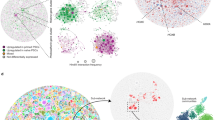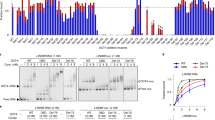Abstract
It is becoming increasingly clear that the shape of the genome importantly influences transcription regulation. Pluripotent stem cells such as embryonic stem cells were recently shown to organize their chromosomes into topological domains that are largely invariant between cell types1,2. Here we combine chromatin conformation capture technologies with chromatin factor binding data to demonstrate that inactive chromatin is unusually disorganized in pluripotent stem-cell nuclei. We show that gene promoters engage in contacts between topological domains in a largely tissue-independent manner, whereas enhancers have a more tissue-restricted interaction profile. Notably, genomic clusters of pluripotency factor binding sites find each other very efficiently, in a manner that is strictly pluripotent-stem-cell-specific, dependent on the presence of Oct4 and Nanog protein and inducible after artificial recruitment of Nanog to a selected chromosomal site. We conclude that pluripotent stem cells have a unique higher-order genome structure shaped by pluripotency factors. We speculate that this interactome enhances the robustness of the pluripotent state.
This is a preview of subscription content, access via your institution
Access options
Subscribe to this journal
Receive 51 print issues and online access
$199.00 per year
only $3.90 per issue
Buy this article
- Purchase on Springer Link
- Instant access to full article PDF
Prices may be subject to local taxes which are calculated during checkout




Similar content being viewed by others
References
Dixon, J. R. et al. Topological domains in mammalian genomes identified by analysis of chromatin interactions. Nature 485, 376–380 (2012)
Nora, E. P. et al. Spatial partitioning of the regulatory landscape of the X-inactivation centre. Nature 485, 381–385 (2012)
de Wit, E. & de Laat, W. A decade of 3C technologies: insights into nuclear organization. Genes Dev. 26, 11–24 (2012)
van Steensel, B. & Dekker, J. Genomics tools for unraveling chromosome architecture. Nature Biotechnol. 28, 1089–1095 (2010)
Splinter, E. & de Laat, W. The complex transcription regulatory landscape of our genome: control in three dimensions. EMBO J. 30, 4345–4355 (2011)
Simonis, M. et al. Nuclear organization of active and inactive chromatin domains uncovered by chromosome conformation capture-on-chip (4C). Nature Genet. 38, 1348–1354 (2006)
Lieberman-Aiden, E. et al. Comprehensive mapping of long-range interactions reveals folding principles of the human genome. Science 326, 289–293 (2009)
Dekker, J., Rippe, K., Dekker, M. & Kleckner, N. Capturing chromosome conformation. Science 295, 1306–1311 (2002)
Splinter, E. et al. The inactive X chromosome adopts a unique three-dimensional conformation that is dependent on Xist RNA. Genes Dev. 25, 1371–1383 (2011)
Splinter, E., de Wit, E., van de Werken, H. J., Klous, P. & de Laat, W. Determining long-range chromatin interactions for selected genomic sites using 4C-seq technology: from fixation to computation. Methods 58, 221–230 (2012)
Wutz, A., Rasmussen, T. P. & Jaenisch, R. Chromosomal silencing and localization are mediated by different domains of Xist RNA. Nature Genet. 30, 167–174 (2002)
McLean, C. Y. et al. GREAT improves functional interpretation of cis-regulatory regions. Nature Biotechnol. 28, 495–501 (2010)
Apostolou, E. et al. Genome-wide chromatin interactions of the Nanog locus in pluripotency, differentiation, and reprogramming. Cell Stem Cell 12, 699–712 (2013)
Handoko, L. et al. CTCF-mediated functional chromatin interactome in pluripotent cells. Nature Genet. 43, 630–638 (2011)
Lin, Y. C. et al. Global changes in the nuclear positioning of genes and intra- and interdomain genomic interactions that orchestrate B cell fate. Nature Immunol. 13, 1196–1204 (2012)
Li, G. et al. Extensive promoter-centered chromatin interactions provide a topological basis for transcription regulation. Cell 148, 84–98 (2012)
Shen, Y. et al. A map of the cis-regulatory sequences in the mouse genome. Nature 488, 116–120 (2012)
Niwa, H., Miyazaki, J. & Smith, A. G. Quantitative expression of Oct-3/4 defines differentiation, dedifferentiation or self-renewal of ES cells. Nature Genet. 24, 372–376 (2000)
Chambers, I. et al. Nanog safeguards pluripotency and mediates germline development. Nature 450, 1230–1234 (2007)
Holwerda, S. J. et al. Allelic exclusion of the immunoglobulin heavy chain locus is independent of its nuclear localization in mature B cells. Nucleic Acids Res. http://dx.doi.org/10.1093/nar/gkt491 (7 June 2013)
Schoenfelder, S. et al. Preferential associations between co-regulated genes reveal a transcriptional interactome in erythroid cells. Nature Genet. 42, 53–61 (2010)
Xu, M. & Cook, P. R. Similar active genes cluster in specialized transcription factories. J. Cell Biol. 181, 615–623 (2008)
Dhar, S. S. & Wong-Riley, M. T. Chromosome conformation capture of transcriptional interactions between cytochrome c oxidase genes and genes of glutamatergic synaptic transmission in neurons. J. Neurochem. 115, 676–683 (2010)
Krijger, P. H. & de Laat, W. Identical cells with different 3D genomes; cause and consequences? Curr. Opin. Genet. Dev. 23, 191–196 (2013)
Noordermeer, D. et al. Variegated gene expression caused by cell-specific long-range DNA interactions. Nature Cell Biol. 13, 944–951 (2011)
Kind, J. et al. Single-cell dynamics of genome-nuclear lamina interactions. Cell 153, 178–192 (2013)
Feng, B. et al. Reprogramming of fibroblasts into induced pluripotent stem cells with orphan nuclear receptor Esrrb. Nature Cell Biol. 11, 197–203 (2009)
Karantzali, E. et al. Sall1 regulates embryonic stem cell differentiation in association with nanog. J. Biol. Chem. 286, 1037–1045 (2011)
Parisi, S. et al. Klf5 is involved in self-renewal of mouse embryonic stem cells. J. Cell Sci. 121, 2629–2634 (2008)
Smith, A. G. Culture and differentiation of embryonic stem cells. J. Tissue Cult. Methods 13, 89–94 (1991)
Peric-Hupkes, D. et al. Molecular maps of the reorganization of genome-nuclear lamina interactions during differentiation. Mol. Cell 38, 603–613 (2010)
Warlich, E. et al. Lentiviral vector design and imaging approaches to visualize the early stages of cellular reprogramming. Mol. Ther. 19, 782–789 (2011)
Andrews, N. C. & Faller, D. V. A rapid micropreparation technique for extraction of DNA-binding proteins from limiting numbers of mammalian cells. Nucleic Acids Res. 19, 2499 (1991)
Laemmli, U. K. Cleavage of structural proteins during the assembly of the head of bacteriophage T4. Nature 227, 680–685 (1970)
Wilson, A. A. et al. Sustained expression of α1-antitrypsin after transplantation of manipulated hematopoietic stem cells. Am. J. Respir. Cell Mol. Biol. 39, 133–141 (2008)
Marson, A. et al. Connecting microRNA genes to the core transcriptional regulatory circuitry of embryonic stem cells. Cell 134, 521–533 (2008)
Creyghton, M. P. et al. Histone H3K27ac separates active from poised enhancers and predicts developmental state. Proc. Natl Acad. Sci. USA 107, 21931–21936 (2010)
Kagey, M. H. et al. Mediator and cohesin connect gene expression and chromatin architecture. Nature 467, 430–435 (2010)
Mikkelsen, T. S. et al. Genome-wide maps of chromatin state in pluripotent and lineage-committed cells. Nature 448, 553–560 (2007)
Meissner, A. et al. Genome-scale DNA methylation maps of pluripotent and differentiated cells. Nature 454, 766–770 (2008)
Acknowledgements
We would like to thank C. Vermeulen and S. Holwerda for counting FISH slides; G. Geeven for the analysis of sequencing data; J. Brandsma for technical assistance; P. Verschure for the LacR–GFP backbone construct; and H. Niwa for providing ZHBTc4 ES cells. We also thank the Netherlands Institute for Regenerative Medicine (NIRM) network for supporting the R.A.P. laboratory and the Medical Research Council UK for supporting the I.C. laboratory. This work was financially supported by grants from the Dutch Scientific Organization (NWO) to E.d.W. (700.10.402, ‘Veni’) and W.d.L. (91204082 and 935170621), InteGeR FP7 Marie Curie ITN (PITN-GA-2007-214902) and a European Research Council Starting Grant (209700, ‘4C’) to W.d.L.
Author information
Authors and Affiliations
Contributions
E.d.W. conceived the study, analysed the data and wrote the manuscript. B.A.M.B. designed and performed reprogramming and knockout experiments, and helped to write the manuscript. Y.Z. and P.H.L.K. designed and performed LacR–Nanog experiments. E.S. and P.H.L.K. performed cell culture and 4C experiments. M.J.A.M.V., E.P.N. and E.H. designed, performed and analysed FISH experiments. M.W. and N.G. assisted with reprogramming experiments. R.A.P. shared Oct4 conditional knockout cells and assisted with depletion experiments. N.F. and I.C. shared conditional knockout cells and assisted with Nanog depletion experiments. W.d.L. conceived the study and wrote the manuscript
Corresponding author
Ethics declarations
Competing interests
The authors declare no competing financial interests.
Supplementary information
Supplementary Figures
This file contains Supplementary Figures 1-16. (PDF 10504 kb)
Supplementary Table 1
This file contains read distributions and 4C experiment characteristics for ESC, NPC, iPSC and astrocytes. (XLS 34 kb)
Supplementary Table 2
This file contains an overview of interchromosomal interactions with Nanog in ESCs. (XLS 37 kb)
Supplementary Table 3
This file contains GREAT enrichment scores for analyzed viewpoints and tissues. (XLS 85 kb)
Supplementary Table 4
This file contains 3D DNA FISH distance scores. (XLSX 30 kb)
Rights and permissions
About this article
Cite this article
de Wit, E., Bouwman, B., Zhu, Y. et al. The pluripotent genome in three dimensions is shaped around pluripotency factors. Nature 501, 227–231 (2013). https://doi.org/10.1038/nature12420
Received:
Accepted:
Published:
Issue Date:
DOI: https://doi.org/10.1038/nature12420
This article is cited by
-
Mapping nucleosome-resolution chromatin organization and enhancer-promoter loops in plants using Micro-C-XL
Nature Communications (2024)
-
NANOG prion-like assembly mediates DNA bridging to facilitate chromatin reorganization and activation of pluripotency
Nature Cell Biology (2022)
-
Extensive co-binding and rapid redistribution of NANOG and GATA6 during emergence of divergent lineages
Nature Communications (2022)
-
CTCF organizes inter-A compartment interactions through RYBP-dependent phase separation
Cell Research (2022)
-
Topological isolation of developmental regulators in mammalian genomes
Nature Communications (2021)
Comments
By submitting a comment you agree to abide by our Terms and Community Guidelines. If you find something abusive or that does not comply with our terms or guidelines please flag it as inappropriate.



